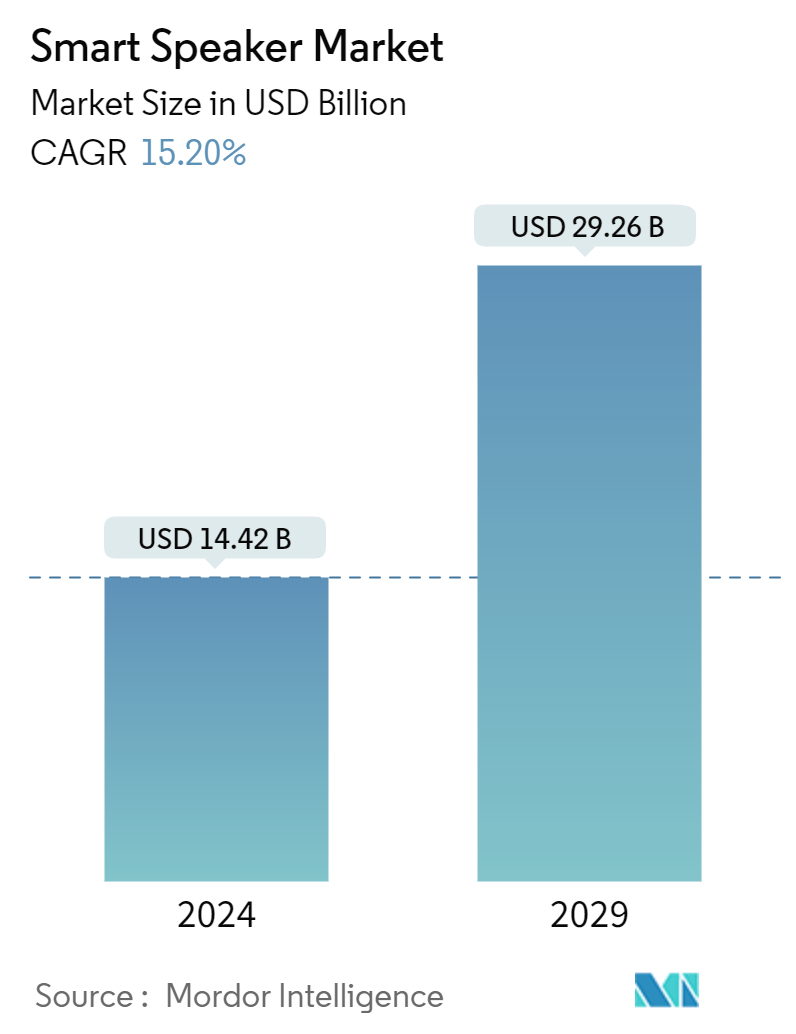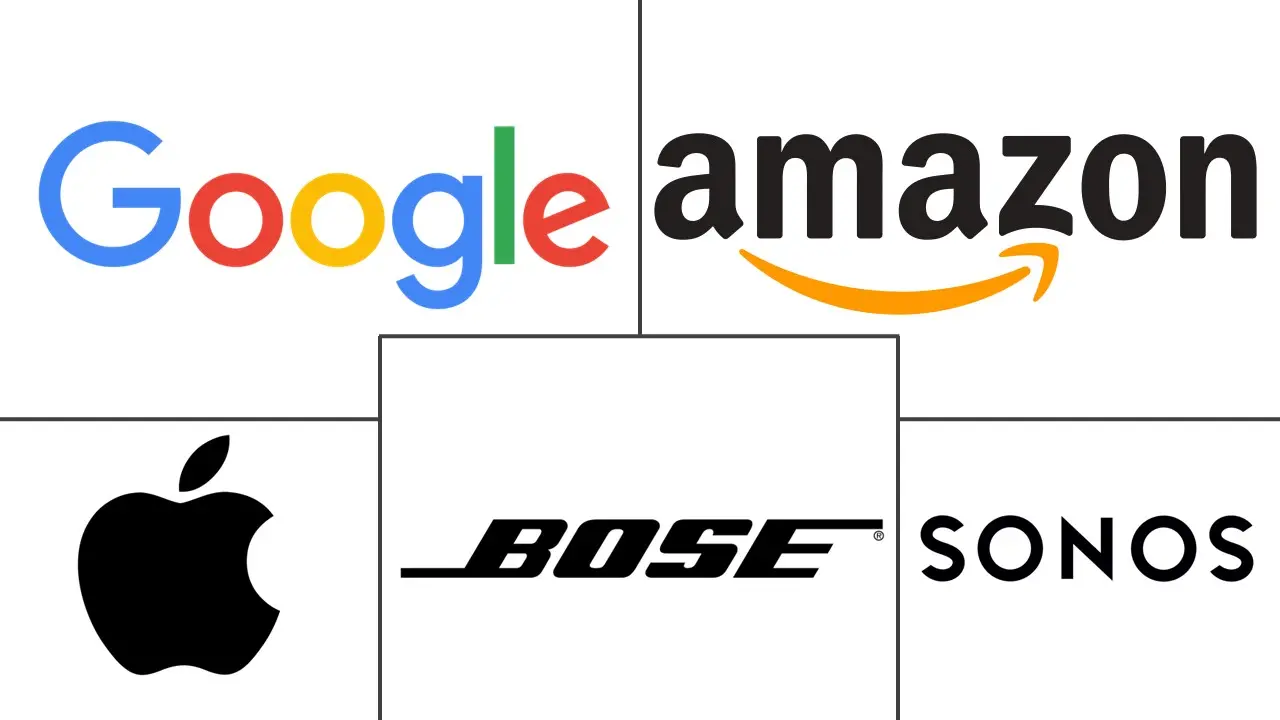Market Size of Smart Speaker Industry

| Study Period | 2019 - 2029 |
| Market Size (2024) | USD 14.42 Billion |
| Market Size (2029) | USD 29.26 Billion |
| CAGR (2024 - 2029) | 15.20 % |
| Fastest Growing Market | Asia Pacific |
| Largest Market | North America |
| Market Concentration | Medium |
Major Players
*Disclaimer: Major Players sorted in no particular order |
Smart Speaker Market Analysis
The Smart Speaker Market size is estimated at USD 14.42 billion in 2024, and is expected to reach USD 29.26 billion by 2029, growing at a CAGR of 15.20% during the forecast period (2024-2029).
- A smart speaker is a loudspeaker and voice command device with a built-in virtual assistant. It allows for hands-free activation and offers interactive actions using a specific "hot word" or multiple ones. These speakers are typically wireless and can connect to Wi-Fi, Bluetooth, or other wireless protocols. They are designed to be activated by voice commands and powered by an intelligent virtual assistant, which assists with various daily tasks.
- Smart speakers have become an essential gadget for numerous enthusiasts of smart technology, as they seamlessly combine convenience, connectivity, and control in a compact speaker. These voice-activated assistants have surpassed their initial functionalities and now excel in streaming music, managing schedules, controlling smart home devices, and searching the web. By employing natural language processing and artificial intelligence (AI) technologies, smart speakers possess the ability to comprehend and answer questions, execute diverse tasks, and offer entertainment.
- The rise in smart home technology and the availability of smart home devices have shifted consumer preferences toward smart speakers. The ability of these products to be controlled through voice commands has been a major driving force behind their increasing popularity. The convenience of controlling various aspects of the home simply by using voice commands has dramatically appealed to consumers, leading to a surge in demand for these products and subsequently boosting the market. Some of the functions and features of smart speakers include voice commands, calls and communication, smart home control, music playback, streaming, entertainment, and media control, among others.
- The market is projected to experience growth in the coming years due to the automation of household chores and the rising need for human-machine interaction. The market is also expected to be driven by the integration of AI technology. Voice-activated devices, which AI assistants support, have become extremely popular and are changing how individuals search for information and carry out their daily activities. With this technological advancement, the significance of voice search optimization has increased notably as businesses and individuals aim to adjust to the evolving digital environment.
- With the increasing demand for these devices, several vendors in the market are constantly investing in introducing various products, helping them gain a competitive edge in the market. For instance, in March 2023, Apple revealed that its redesigned HomePod is expected to be released in the first half of 2024, along with a 7-inch touchscreen display. The second-generation Apple HomePod was introduced earlier in 2023. Equipped with Siri, Apple's voice-activated personal assistant, the intelligent speaker includes built-in sensors and an EQ microphone. The latest HomePod runs on Apple's proprietary S7 chipset and can function as an in-home intercom system.
- Furthermore, it is projected that Google's virtual assistant will experience substantial expansion in the foreseeable future, positioning itself as the dominant IVA category. The adoption of Google Home voice assistant in Asia is predicted to surge, particularly with Google introducing its offerings in various countries. Currently, the Chinese market is characterized by established players such as Alibaba, Xiaomi, and JD.com. The rising investments in smart home technology throughout APAC nations, coupled with the increasing desire for smart devices among households in the region, are also poised to propel the market forward.
- Furthermore, security and privacy concerns arise with smart speakers, especially those utilizing a microphone for voice recognition. Voice data is uploaded to servers via the Internet by multiple services. The activation of speakers through voice commands like "Alexa," "OK Google," and "Siri" poses a risk of potential misuse of data and voice patterns for various purposes, causing apprehension among consumers. The market's growth is expected to face challenges due to the rise of data-driven innovations.
Smart Speaker Industry Segmentation
A smart speaker is a wireless electronic device typically equipped with Wi-Fi connectivity and integrated voice assistants such as Amazon Alexa, Google Assistant, and Siri. These convenient devices can be operated remotely through voice commands, also allowing users to manage other smart home gadgets.
The smart speaker market is segmented by intelligent virtual assistance (Amazon Alexa, Google Assistance, Apple Siri, and DuerOS), component (hardware and software), application (smart home, smart office, and consumer), and geography (North America, Europe, Asia-Pacific, Latin America, and Middle East and Africa). The report offers market size and forecast for all the above segments in value (USD).
| By Intelligent Virtual Assistance | |
| Amazon Alexa | |
| Google Assistance | |
| Apple Siri | |
| DuerOS |
| By Component | |
| Hardware | |
| Software |
| By Application | |
| Smart Homes | |
| Smart Office | |
| Consumer |
| By Geography*** | |
| North America | |
| Europe | |
| Asia | |
| Australia and New Zealand | |
| Latin America | |
| Middle East and Africa |
Smart Speaker Market Size Summary
The smart speaker market is poised for significant growth, driven by the increasing integration of artificial intelligence and the rising demand for smart home technology. These devices, which combine voice-activated assistants with speaker functionality, have evolved beyond their initial capabilities to offer a wide range of features, including music streaming, smart home control, and web searching. The convenience of hands-free operation and the ability to manage various home devices through voice commands have made smart speakers a popular choice among consumers. As the market expands, companies are investing in innovative products and technologies to maintain a competitive edge, with major players like Amazon, Google, and Apple leading the charge.
In the Asia-Pacific region, the smart speaker market is experiencing robust growth due to the increasing adoption of Internet-of-Things (IoT) technologies and wireless devices. Countries such as China, India, and Japan are witnessing a surge in demand for these devices, fueled by consumer preferences for convenience and the proliferation of smart home systems. The market's expansion is further supported by advancements in 5G infrastructure and the growing popularity of voice assistants. Despite concerns over security and privacy, the market is expected to continue its upward trajectory, with local alternatives gaining traction alongside established brands. The ongoing development of multilingual support and regional adaptations is anticipated to enhance the market's growth potential in these regions.
Smart Speaker Market Size - Table of Contents
-
1. MARKET INSIGHTS
-
1.1 Market Overview
-
1.2 Industry Value Chain Analysis
-
1.3 Industry Attractiveness - Porter's Five Forces Analysis
-
1.3.1 Bargaining Power of Suppliers
-
1.3.2 Bargaining Power of Consumers
-
1.3.3 Threat of New Entrants
-
1.3.4 Threat of Substitute Products
-
1.3.5 Intensity of Competitive Rivalry
-
-
1.4 Impact of COVID-19 Aftereffects and Other Macroeconomic Factors on the Market
-
-
2. MARKET SEGMENTATION
-
2.1 By Intelligent Virtual Assistance
-
2.1.1 Amazon Alexa
-
2.1.2 Google Assistance
-
2.1.3 Apple Siri
-
2.1.4 DuerOS
-
-
2.2 By Component
-
2.2.1 Hardware
-
2.2.2 Software
-
-
2.3 By Application
-
2.3.1 Smart Homes
-
2.3.2 Smart Office
-
2.3.3 Consumer
-
-
2.4 By Geography***
-
2.4.1 North America
-
2.4.2 Europe
-
2.4.3 Asia
-
2.4.4 Australia and New Zealand
-
2.4.5 Latin America
-
2.4.6 Middle East and Africa
-
-
Smart Speaker Market Size FAQs
How big is the Smart Speaker Market?
The Smart Speaker Market size is expected to reach USD 14.42 billion in 2024 and grow at a CAGR of 15.20% to reach USD 29.26 billion by 2029.
What is the current Smart Speaker Market size?
In 2024, the Smart Speaker Market size is expected to reach USD 14.42 billion.

